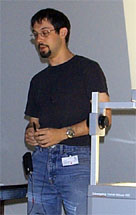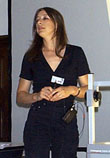ICCBR'99 Day Three
| Morning Sessions - this is where I need some help. My excuse is that the Bavarians operate a strange system in their bars (very strange to the English and Irish present) - namely you can drink as much as you like without paying until you leave the bar. The flaw in this hospitable policy is that you can't run out of money whilst you're drinking - as a consequence I can't actually remember any of Thursday morning's sessions (I think I was asleep). So if you were there and would like your comments to appear here your help would be very much appreciatedappreciated. |
| After lunch (or breakfast) we had a session on integration issues. Qiang Yang presented a paper called Activating CBR Systems through Autonomous Information Gathering (Carrick & Yang & Abi-Zeid & Lamontagne).Illustrated with Qiang's familiar cable TV help desk application the system integrates information from several heterogeneous data sources. Of interest is that the system is able to estimate the "cost" of obtaining information from a certain data source and use this as a heuristic to guide an information gain policy. Whilst it seems that this might be overkill for the application presented it could clearly be of great use in a distributed Internet environment where information was being sourced from a variety of commercial sources (e.g. financial and news wire services). |
|
| It was the turn of the two Davids again
with a presentation called Integrating CBR with Interactive Tools for Acquiring,
Manipulating, and Reusing Design Knowledge (Leake & Wilson). This describes work
at NASA using concept maps to help engineers and designers record and reuse design
knowledge. Designs (of aircraft) are recorded as concept maps (non formal semantic
networks) and can be retrieved by browsing or by using a feature based retrieval technique
Once retrieved designs can be adapted manually of by using feature substitution. I was
really interested in this paper because the designers' concept maps are very similar to
the "bubble diagrams" that architects use - anybody want to collaborate on a
research project with me to capture and reuse architectural design knowledge? Download the paper. |
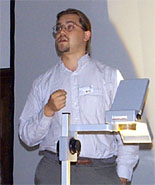 |
| We then listened to a presentation called Integrating CBR and Heuristic Search for Learning and Reusing Solutions in Real-Time Task Scheduling (Cuello & Camilo dos Santos) that presented a "classic" CBR system for scheduling that retrieves similar past problems and their schedules and then uses heuristic search to generate a complete schedule. The problem for me with this work is that it doesn't really advance the state-of-the-art very much. There were no surprises here. |
|
| Mercees Gómez-Albarrán presented a paper Modelling the CBR Life Cycle using Description Logics (Gómez-Albarrán & González-Calero & Díaz-Agudo & Fernández-Conde). Operating in the domain of software reuse they use instance based retrieval with domain dependent similarity metrics along with a variety of different techniques for performing retrieval, similarity assessment and adaptation. |
|
| In general the session on integration didn't hang together for me as well as the session on maintenance had. Of course, it's not such an easily defined problem. The next session was on adaptation - traditionally a very contentious issue at CBR meetings. Andres Gomez de Silva Garza presented An Evolutionary Approach to Case Adaptation (Gomez de Silva Garza & Maher). This work uses GAs to adapt design cases to satisfy a problem description. I was puzzled how a GA fitness function could evaluate the "fitness" of a design until Andres revealed that his application area was design according to the Chinese feng shui principles. It the became clear that it was possible to decide is a house design was "fit" according to feng shui. This clear measure of success would seem very unusual in most design environments, However, he has applied similar techniques to structural engineering design which is of more practical interest. |
|
| Beatrice Fuchs ended the session with A
Knowledge-Level Task Model of Adaptation in CBR (Fuchs & Mille). The motivation
behind this research was the lack of formal definition of the processes in the CBR-cycle,
adaptation in particular. Drawing on the "components of expertise"
model they've analysed several well known CBR system. The results of this have then been
used to help them design their own CBR tool Rocade. Somewhat disappointingly, adaptation did not cause the heated debates that it has at previous meetings. |
|
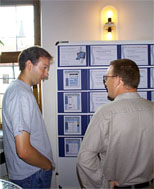 |
The day then concluded with the workshop organisers
presenting a summary of their workshops and the poster presentations in the dining hall.
Everyone I spoke to was very impressed with the strength and quality of the work presented
in the posters. Clearly it is a very difficult task for the programme chairs to decide who
gets to present at ICCBR such is the overall quality of the work submitted. After exploring the posters and eating dinner we then had the CBR Games Evening, which centred upon the Chess Tournament, Bowling, Black Jack and competitive drinking! |
 |
I'm afraid the chess was played so fast I couldn't
register the board positions before the moves were made. The winner of the chess
tournament was Iglezakis Ionannis pictured on the right. However, the bowling proved to be even more challenging - and yes the Monastery has a bowling alley - don't ask it's something to do with the patron saint of bowling being a Bavarian monk. |
 |
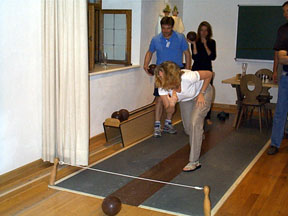 |
Believe it or not it took 5 hours (from 10pm to 2am)
for one of us to get a strike! Congratulations to Ivo Vollrath who eventually showed us
how it should be done. ...and the evening was not over . Several CBRers demonstrated their musical talents and Hector (who I thought was the quiet type) invented a drinking game. |
 |
 |
Hector's drinking game is very simple.
He's from Columbia so he buys everyone a shot of tequila. Then Eric from France buys
everyone a cognac, Wolfgang (German) a schnapps, Ian (Scottish ancestry) a whisky and so
on... Guess who didn't make the first session at 8.30am the following morning? |



